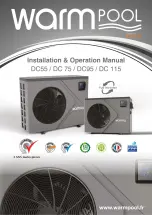
Installation Manual
17
17-EN
T
In case of bottom right or bottom left piping
• After scribing slits of the front panel with a knife or a marking-off
pin, cut them with a pair of nippers or an equivalent tool.
Slit
T
Left-hand connection with piping
Bend the connecting pipe so that it is laid within 43
mm above the wall surface. If the connecting pipe
is laid exceeding 43
mm above the wall surface, the indoor unit may unstably be set on the wall.
When bending the connecting pipe, make sure to use a spring bender so as not to crush the pipe.
Bend the connecting pipe within a radius of 30 mm.
7RFRQQHFWWKHSLSHDIWHULQVWDOODWLRQRIWKHXQLW¿JXUH
570 mm
420 mm
43 mm
Liquid side
Gas side
7RWKHIRUHIURQWRIÀDUH
Outward form of indoor unit
R 30 mm (Use polisin (polyethylene)
core or the like for bending pipe.)
Use the handle of screwdriver, etc.
80°
NOTE
If the pipe is bent incorrectly, the indoor unit may unstably be set on the wall.
After passing the connecting pipe through the pipe hole, connect the connecting pipe to the auxiliary
pipes and wrap the facing tape around them.
CAUTION
• Bind the auxiliary pipes (two) and power supply wiring and control wiring with facing tape tightly.
In
case of leftward piping and rear leftward piping, bind the auxiliary pipes (two) only with facing tape.
Indoor unit
Power supply wiring
Control wiring
Auxiliary pipes
Installation plate
• Carefully arrange pipes so that any pipe does not stick out of the rear plate of the indoor unit.
• Carefully connect the auxiliary pipes and connecting pipes to one another and cut off the insulating
tape wound on the connecting pipe to avoid double-taping at the joint; moreover, seal the joint with
the vinyl tape, etc.
• Since dew results in a machine trouble, make sure to insulate both the connecting pipes.
(Use polyethylene foam as insulating material.)
• When bending a pipe, carefully do it, not to crush it.
















































